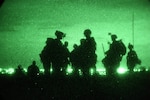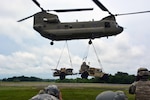Network Integration Exercise Prepares Soldiers for Future Combat
U.S. Department of Defense sent this bulletin at 08/03/2017 12:46 PM EDTYou are subscribed to no topic for U.S. Department of Defense. This information has recently been updated, and is now available.
Network Integration Exercise Prepares Soldiers for Future CombatBy Devon L. Suits Army Media Production, Defense Media Activity FORT BLISS, Texas, Aug. 3, 2017 — As potential adversaries continue to develop their ability to engage with U.S. forces across multiple domains, the Army's future operating environment will be highly contested, congested, and lethal. That's why exercises such as the Network Integration Evaluation are vital for building an agile and adaptive Army by integrating and testing new network equipment that will be used in the field. |
||||
Related Images
|



